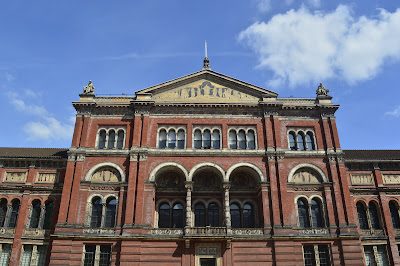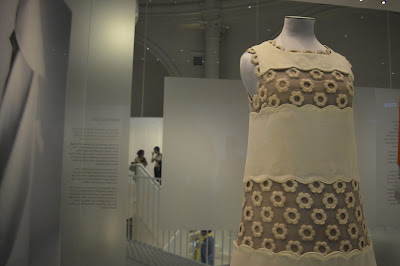The name Balenciaga may not be as ubiquitous in the mainstream history of fashion such as contemporaries Chanel or Givenchy but his legacy is, if not more far-reaching. His shyness towards the press may have been a short-fall but for his ingenuity and influence his name is synonymous with pioneering. For this reason, the V&A want to re-write the history books with this detailed and educational retrospective. It’s the very first show dedicated to the designer in the UK and falls on the centenary, displaying 100 garments and 20 hats. This particular show pin-points his most creative period between the 1950's and 1960's by using an incredible 70% of the museum's own archive. As some pieces are too precious to exhibit they have been presented as giant X-ray scans to reveal the inner-constructions such as weights sewn into hemlines to determine hang.
This kind of detective work from the curators of "Shaping Fashion" is a good indicator of the level of close detail put into telling the story of Cristóbal Balenciaga. His history is divided into 3 themes with an additional gallery charting the timeline of successors who have been inspired by his avant-garde, architectural approach to garment construction. Here lies a gallery of modern fashion design in its own right as a stand-alone gathering of Courrèges to Iris Van Herpen and Paco Robanne to Chalayan. Crucially, within the collection are examples from Nicolas Ghesquière's helm at the house which he took on at the spritely age of 25 (which I don't think I fully appreciated at the time)! It's just as exciting to see these looks up close now as it was to see them appear each season in that chapter. Now currently under the creative leadership of Vetements head-designer Demna Gvasalia, its key that we go back to the very start and understand how the Spanish talent made this vanguard Parisian institution.
Balenciaga had an immediate introduction to the art of dress-making from his mother and later studied tailoring after an apprenticeship, aged 12. The combination of these two disciplines made him deft in both flat pattern-cutting and draping which was an advantage in defining his understanding of form. His design process always began with the fabric and experimenting with how it would fit to the body rather than sketching. This technique engineered the one-piece pattern and minimal seams of his signature style. Stiff fabrics became architectural silhouettes (Gazar silk) and looser softer styles flowed with hidden corseting. You can detect his influences direct from his Spanish heritage amongst these choices such as lace mimicking the mantilla or embroidery from a Matador Jacket. Regional dress was a significant source of inspiration from “Bata De Cola” flamenco dress to the soutanes worn by Spanish clergy and “Mozzetta” capes of clerics and monks. In addition to this, Balenciaga investigated non-Western ways of clothing the body and garments of few seams such as Kimonos. All of these sources generated his revolutionary version of the female silhouette as an abstract vision in contrast to the waisted hourglass of the era.
By eliminating the waist, his “sack dress” of the late 1950’s anticipated the shift dress of the 1960’s. Although ridiculed in its time for being unflattering, we can now appreciate his radical foresight with the benefit of fashion's evoultion. The fact that he cast and trained his own unconventional models for the salon shows further proves his preoccupation with celebrating the female form. He wanted to frame the body rather than restrict it. He was a skilled craftsman who explored scale, shape and unusual materials to innovate and push boundaries.
“Balenciaga uses fabric like a sculptor working in marble” Cecil Beaton
As an example of this preoccupation, Balenciaga considered hats integral to the whole look and silhouette. Couturiers usually out-sourced hats but he set up two of his very own millinery ateliers to focus on the collections’ headwear. These surreal constructions are one of the best sections of the show (for me!) and neatly and exquisitely demonstrate his innovation. There are leaf embellishments made from cellophane and plastic beading in collaboration with embroiders Lesage. The examples on show are complimented with hat design sketches, illustrations and boards of fabric swatches. Its heaven for any hat-maker, especially designer Noel Stewart who has been commissioned to create a capsule collection for the exhibition’s gift shop.
The curators also worked with students from the LCF MA course to replicate garments in calico to display alongside the originals. A lot of Balenciaga’s magic is only evident in concealed layers that lie beneath, so they have wired up sections to best demonstrate these methods. In addition to this, animations of the pattern pieces whirl on screens next to each case so you can visualise how a garment has come together. In honour of Balenciaga’s overwhelming care and consideration, the V&A have gone to great lengths in outlining, demonstrating and sharing as much knowledge as possible. It’s taken me a week to get around to writing this because I didn’t know where to start with the incredible insight I amassed from all these sources. It’s excellent to see his lace “Baby Doll” dress from 1958 in one case and then follow up with Molly Goddard’s recent tulle shift and comprehend the extent of his influence. Despite however much or little you may already know about Cristobel Balenciaga; the V&A have done him proud in their extensive portrayal. I recommend this as a No.1 Summer show, especially followed up with a sun bathed coffee in the Museum’s glorious central court garden!






















No comments:
Post a Comment